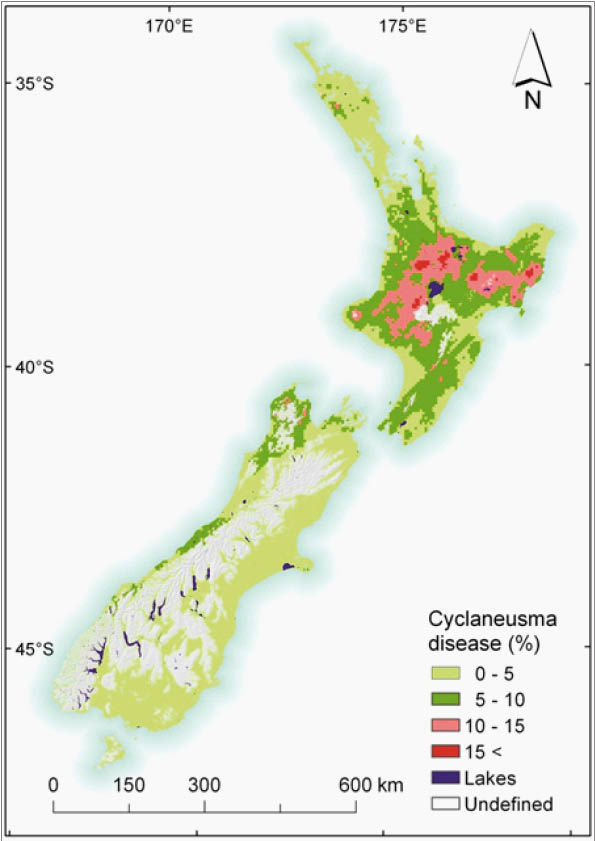PESTS AND DISEASES OF FORESTRY IN NEW ZEALAND
Predicting the severity of Cyclaneusma minus on Pinus radiata in New Zealand
Scion is the leading provider of forest-related knowledge in New Zealand
Formerly known as the Forest Research Institute, Scion has been a leader in research relating to forest health for over 50 years. The Rotorua-based Crown Research Institute continues to provide science that will protect all forests from damage caused by insect pests, pathogens and weeds. The information presented below arises from these research activities.
From Forest Health News 217 July 2011.
Cyclaneusma needle cast caused by the pathogen Cyclaneusma minus occurs widely in Pinus radiata plantations throughout New Zealand. The disease, which began causing real concern in the late 1950s, is characterised by yellow and brown mottling of needles which are prematurely cast.

In 2009, the losses caused by cyclaneusma needle cast were estimated to be around $38 million per annum. Given the high impact of cyclaneusma needle cast on plantation forests, Scion undertook a study to explore the relationship between disease severity and environmental conditions throughout the country. The first step in the study was to develop a model for predicting disease severity, using an extensive set of observations of cyclaneusma needle cast, collected over four decades across New Zealand.
The model showed that disease severity is most sensitive to elevation, followed by mean winter air temperature, mean relative humidity during July, then stand age. Severity increased to a maximum at mean winter air temperatures of between 7 and 9°C before declining. Values of severity were found to be highest in moderately warm, wet and humid high elevation environments located in the central North Island. In contrast, relatively low values of severity were predicted in drier eastern and southern regions of New Zealand.
Results from this study broadly agree with previous research that demonstrated the influence of environment on development of Cyclaneusma over a number of important stages in the life cycle. The model provides a valuable baseline for researchers to predict the likely impact of cyclaneusma needle cast under future climate scenarios.
This project was part of a larger research programme funded by the Ministry of Agriculture and Forestry (MAF) to predict the likely impacts of climate change on plantation forests. This information is seen by MAF as an important step towards risk management and adaptation. Studies involve modelling the direct effects of changes in environmental conditions on tree growth, and indirect impacts caused by changing wind, fire and disease risks.
Improved understanding of environmental drivers will ultimately help managers to make informed decisions on future siting of plantation species or management of existing species. The type of information arising from this study could be combined into a decision support system that allows comparison of future productivity for commonly occurring plantation species, or silvicultural regimes, across New Zealand.
Michael Watt, Carol Rolando, David Palmer and Lindsay Bulman
This information is intended for general interest only. It is not intended to be a substitute for specific specialist advice on any matter and should not be relied on for that purpose. Scion will not be liable for any direct, indirect, incidental, special, consequential or exemplary damages, loss of profits, or any other intangible losses that result from using the information provided on this site.
(Scion is the trading name of the New Zealand Forest Research Institute Limited.)

 Farm Forestry New Zealand
Farm Forestry New Zealand

